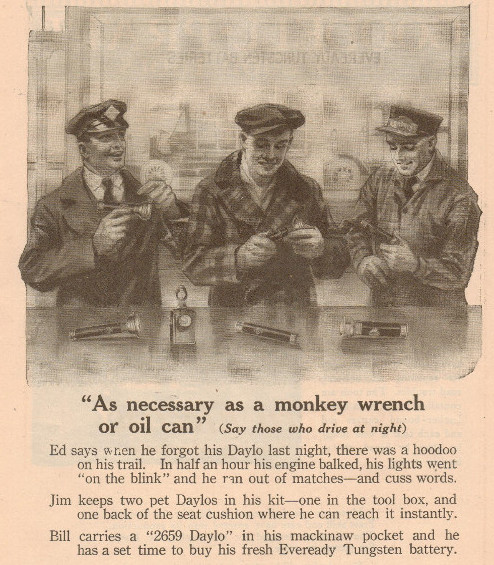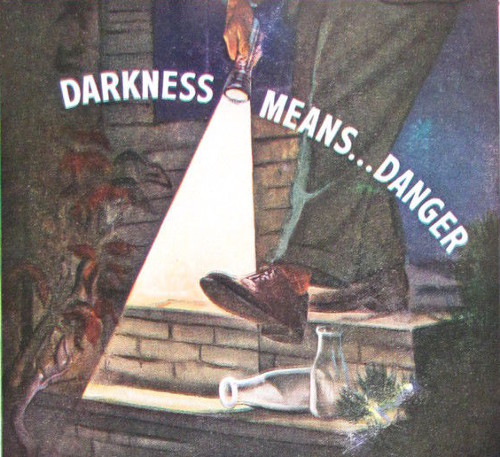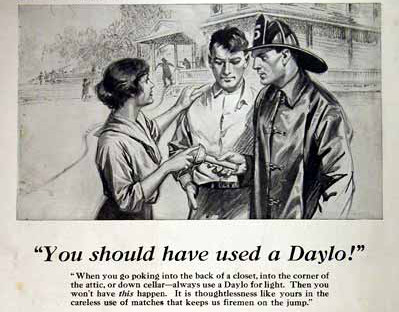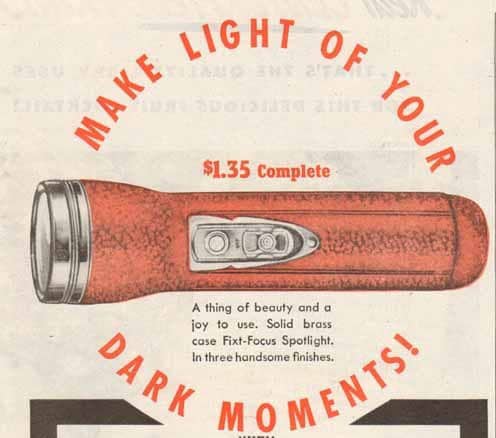
From helping you find your way back to your campsite, to allowing you to find a missing widget under the bed, to providing illumination when the lights go out, to warding off a would-be attacker, there are few tools as handy and essential as the flashlight. And there are few tools that elicit as much affection and attachment. I think our British friends’ word for the flashlight – torch – gets right to the heart of the appeal. The flashlight is simply the latest iteration of the ancient need to carry fire in one’s hand.

If I learned one thing from the Hardy Boys, it’s to always carry a flashlight!
As we’ve moved from burning branches to battery-powered tubes, the number of options for handheld light has multiplied. You may think that all flashlights are the same, but boy you’d be wrong. There’s more to know than you could possibly imagine. Today, we’ll stick to the basics that every man should know and consider when buying a flashlight.
Five Basic Categories of Flashlights

Keychain/EDC. Typically 3†or less in length, these flashlights are an essential part of one’s EDC (Everyday Carry) kit. Their small size allows you to stick them in your pocket, stash them in various bags, or — and this is the easiest, most foolproof option — attach to a keychain. With their low light, they are intended to be used as a backup or emergency flashlight, not your primary one. The plastic variety often runs on coin cell batteries, like what you’d find in a watch, so when it dies, you’re better off replacing it entirely versus going through the hassle of replacing the battery. There are also some slightly higher-powered aluminum versions out there that will run on a single AA or AAA battery. In general, a keychain light won’t run you more than $10.
Utility. This is what you’ll find in most houses as a general use flashlight. It’s not a serious light by any means. It’s probably lightweight, made of plastic, and gives off just enough light to get the job done. They’re cheap, and will last a few years for your most basic flashlight needs.
Tactical. Brett has explained exactly what makes a flashlight “tactical†in a previous post (he also outlines how to use one): “A tactical flashlight is simply a flashlight that’s been designed for tactical (i.e. military or police) use. Many tactical flashlights are designed to be mounted to a weapon for low-light shooting. They’re typically smaller than traditional flashlights, emit much more light, and are made of weapon-grade aluminum for maximum durability. While tactical flashlights are designed primarily for military and police units, they’re also a really handy everyday and personal defense tool for the average civilian.â€
These will generally be 3-7†in length, and are meant to be carried on your person as a self-defense tool. They may be small, but they pack a punch. I’m making a few broad generalizations here, but they’re generally made of aluminum, will be between 100-500 lumens (more on that later), and should run you between $30-$100.
Heavy-Duty or Industrial. These are the heavy, generally aluminum flashlights that you have in your house or garage, or on a worksite for extended use. Because of their hefty weight, some people carry them as a personal defense weapon as well. Think classic Maglite for this category. They give a lot of power but retain their handy size at generally between 5-14†long. They’re usually too big for a pocket, but still easily handheld. Prices vary widely on these flashlights — anywhere from $20 to a few hundred.
Emergency. These are hand-cranked or solar powered lights that don’t rely on batteries. They’re used mainly in emergency kits.

Headlamps are another light option too, but this post focuses on the handheld variety.
Options and Functions to Consider When Buying
Next, we’ll go through the various options and features you’ll find when shopping for flashlights. The majority are simply user preference, but I’ll outline pros and cons where appropriate.
Battery Type

What kind of battery will your flashlight run on? Most flashlights will run on either AA or AAA batteries, but you’ll also find ones that run on C, D, or 9-volt batteries. Some flashlights will run on lithium batteries, which are better for long-term storage and cold operating conditions. Be sure to check the packaging or product details, however, because not all flashlights will accept them.
Generally, flashlights with multiple brightness levels have longer run times. There’s also the renewable energy type (emergency lights) as mentioned above that are hand-cranked or solar powered. No matter which light you go with, you’ll want to have plenty of batteries on hand, so stock up. It’s also a good idea to keep a few batteries close to where you store each flashlight in your house or in your EDC kit.
You also want to be sure to know about the ease of changing the batteries. Some lights may require a small screwdriver, while some may have a slip-off case like a remote control would. Keep this small detail in mind while shopping.
Material

There are two main types of material for flashlights: plastic and aluminum. Some models have stainless steel in the head for greater impact resistance. Aluminum is usually known to have greater durability, but it can get extra hot/cold and is heavier than plastic models. This is simply user preference, but unless it’s a high-grade plastic material, aluminum will be your best bet.
Bulb
LEDs have come to rule the flashlight market. The bulbs last up to 100,000 hours, are incredibly durable, use only 20-25% the energy of an incandescent, and generally provide all the light you could possibly need. Incandescent bulbs have a softer light, which some people prefer, and are cheaper. They are more fragile, however, and break easily when dropped. They also have a much shorter shelf life not only with the bulb, but they use up your light’s battery juice much quicker, as well.
How to Operate

Is it a push button, a slider, or a rotating bezel that turns the light on and off? This is something to truly think about. How will you be using your flashlight? A rotating bezel will require two hands to turn it on and off. A push button may have a more audible click than a button that slides up/down. There are also lights that have a non-clicking insta-beam, which turns the light on by just depressing the button, and it will turn back off once you remove pressure. That could be handy in a situation where absolute silence is paramount, or you need just a quick flash of light. The feature could also make emergency signaling easier, as you don’t have to toggle a light fully on/off while giving the SOS. Tactical flashlights often have a push button on the tail-end, making them easy to hold like a weapon and operate with just a thumb.
Additional questions to consider are if the light could accidentally turn on inside a pack or large pockets. Also think about if you’ll be operating it with gloves on, and how that could impact ease of use.
Reflectors and Lenses

The reflector is parabolic in shape and organizes the light from the bulb into a focal point. Deep and narrow reflectors will have a more concentrated beam over a long distance (also called a “throw†beam). Wide and shallow reflectors (like on a floodlight) will give a wider, less concentrated beam (“flood†beam).
Lenses are usually flat, and are either made of plastic or glass, with glass generally being preferred (although you’ll find as many opinions on this as people). Plastic has a tendency to discolor over time – see car headlights as an example. And although the average user isn’t likely to run into this, a bright enough bulb can melt or disfigure a plastic lens. As for scratch and impact resistance, it just depends on the quality of the plastic or glass in question. Both materials can last for many years if they’re high quality, but glass will tend to shatter a little easier.
A glass lens with anti-reflective coating is even better than plain glass (not possible with plastic lens), as it allows more light to pass through without being bounced back into the reflector. Some flashlights do have curved lenses, which concentrate the beam even more. And some lights will have adjustable lenses that let you switch between a wide flood beam and a throw beam.
How Many Modes?
Many modern flashlights, especially of the tactical variety, will have multiple modes of operation. It can be as simple as three or four levels of brightness, or as complex as having built-in emergency light strobes, or even programmable modes that can be loaded onto the light by the user.
Grip

A smooth, plastic flashlight is liable to slip out of your hands when working in wet conditions, or if you’re sweating. Make sure that you can grip the flashlight firmly, even when your palms are sweaty (a common occurrence when nervous or stressed – like while frustratedly working on a car, or checking your home at night for an intruder).
Performance Specifications

As with anything you buy, there are certain performance indicators to look for. With cars, you look at horsepower, gas mileage, towing capacity, etc. There isn’t necessarily a best/worst or right/wrong for these specifications, it simply comes down to what you need and prefer as a user. Flashlights are much the same way. There are anywhere between 4-6 specifications you’ll see when looking for lights. They aren’t necessarily better or worse, just different depending on what your needs are.
There is actually a standard for flashlight performance. It was published in 2009 by the American National Standards Institute and is called the Flashlight Basic Performance Standard (or “FL1 Standard†for short). The FL1 Standard outlines four categories of flashlight performance. The categories are as follows:
- Beam Distance (meters): Technically, this is how far the light will shine before the brightness diminishes to the equivalent of the light from a full moon, because full moon illumination is considered adequate for safe and careful travel outdoors. Having said that, a full moon is not actually that much light, so keep that in mind. When evaluating your needs, as with any of these indicators, think about how you’ll be using the flashlight. If you need to illuminate an object from a distance, this is the measurement to focus on. For camping or outdoors use, you may want a longer beam distance than for household use.
- Peak Beam Intensity (candelas): The candela is a unit of luminous intensity — in other words, a measure of a flashlight’s brightness. One candela is roughly the equivalent of the brightness of a single candle from a foot away. This can be hard to interpret, because perceived brightness is non-linear — meaning that twice the candelas (abbreviated “cdâ€) is not twice the brightness. When comparing lights, keep in mind that twice the brightness will actually be about four times the candelas. You may still see the term “candlepower†(or “candle powerâ€) in places, but it’s been deemed obsolete and was officially replaced by the term “candela†over 60 years ago. Another way to think about intensity is that this is how focused the light is. If light is more focused/concentrated, it will naturally be brighter. Now, what to do with this information? Again, you must think about use. If using in a garage at night, you won’t need a high intensity. Generally speaking, for work at close range, you don’t need a focused light, you just need light, period. In these instances, look more at lumens (below). If you need a focused beam, say for spotlight use or outdoors use, this measurement of intensity is what to look at.
- Run Time (hours/minutes): This is simply how long it takes the light output to drop to 10% of the initial output on new batteries, rounded to the nearest quarter-hour.
- Light Output (lumens): A unit of measure of the light’s total output. This measurement can be anywhere from 1 lumen (keychain lights) to multiple thousands (search lights). This is different than beam distance or intensity in that it simply measures how much light is being emitted out of the lens, whereas intensity measures the brightness of a beam at its most intense point. A flood light could have 1,000 lumens, but the light would spread widely over a given area, meaning less intensity. A throw bream could also have 1,000 lumens, but be narrowly focused into a one-foot area. Therefore the throw beam would have a much higher candela reading. Another example of lumens versus intensity that can help make the distinction more clear is a laser. It has incredibly low total output (lumens) but it has incredibly high intensity (candelas) because it’s so focused. Keep in mind that the higher the lumens, the shorter the run time, in most cases. The lumens number is generally the first thing that people look at when buying flashlights. It’s sort of the base performance number. Once you determine how much light you’ll need, then you can get into the specifics of distance and intensity.

How Many Lumens Do You Really Need?
It can be tempting to say you want a 4,000-lumen flashlight. If you’re going to have the tool, why not have the best and most powerful tool possible? The reality is that the vast majority of people will never need more than 150 or so lumens. This is why most flashlights will be between 10-100 lumens, with tactical and super heavy-duty lights going above that. Police officers carry lights that are around 100, and it’s been said that 80 lumens will temporarily blind an assailant. If you aren’t sure of you exact needs, variable brightness lights work great. They generally range from 20-100+ lumens, with three or four levels of brightness. If there’s only one lumens number on a variable flashlight, it’s the max number. Let’s take a look at a few use cases so you can determine what’s best for you:
- 1-20 lumens: finding keyholes, close-range use, walking in the dark, reading in the dark.
- 10-25 lumens: general household use, when the lights go out.
- 35-60 lumens: general outdoors uses, car repairs, hiking/camping in the woods.
- 100+ lumens: tactical lights, security purposes, work duties (police, firemen, construction).
- 1,000+: search and rescue, caving, heavy-duty outdoors uses.
- Water Resistance (uses IP ratings). Some lights will also have ratings for water and impact resistance. Water resistance is rated using the IP system. This is obviously important if using your light in the rain or around bodies of water. Three ratings are used for flashlights:
- IPX4 — splash resistant from all angles, after the impact test (see below) has been applied.
- IPX7 — temporary immersion of up to 30 minutes at a depth of 1 meter.
- IPX8 – submersion up to 4 hours at the specified depth.
- Impact Resistance (meters). Tested by dropping the light onto a concrete surface at the rated distance with all bulbs, lenses, batteries, etc. The light will still function after being dropped from this height. As with any electronics device, however, treat it with care. This test is primarily to ensure the light remains functional after occasional accidental drops. It is not a test of resistance for a light being run over, being struck with a heavy object, or being used to strike other objects.
Because this is a voluntary standardization, not all flashlight manufacturers abide by them. If you’re out and about looking, however, you’ll recognize the terms used, as those should be the same.
What Next?

Always have a flashlight ready or risk burning down the house and being berated by your local fireman, you thoughtless oaf.
Now that you have all this information, what do you do with it? The following three websites are incredibly helpful for learning even more, and getting specific reviews for lights. If you have questions, the forums are incredibly helpful and welcoming to beginners.
- http://www.candlepowerforums.com/ (an exceptionally useful forum – will answer almost any flashlight question you could have, while getting a variety of opinions)
- http://flashlightwiki.com/Main_Page
- www.light-reviews.com
For the Average Joe – the guy who isn’t going to turn into a flash-aholic – there are a few basics you should consider:
Keychain flashlights can come in handy — make one part of your EDC. You never know when you’ll need a light for something. Many people will also use their smartphone’s light (either built-in or via an app) for situations when they’re in a pinch. That’s a fine option, but keep in mind that you often first have to navigate your phone to get to the light, and it also drains the battery quickly. A light on your keychain can be activated in seconds and is much more reliable (and durable, for that matter).

Sometimes the thing that goes bump in the night turns out only to be a piano-playing cat (keyboard cat’s grandma, perhaps?). But it’s good to have a tactical flashlight on hand anyway.
Consider having one or two tactical flashlights in your possession. One can be carried as a personal defense tool, and another can be in a gloveseat, in a bedroom nightstand, or where you may keep a gun in your home.
For your garage/household needs, a couple heavy-duty aluminum flashlights and/or floodlights should get the job done just fine. Maglites are a proven classic, and won’t break your bank. It’s a good idea to have one in the kitchen (or wherever your central meeting place is for your household in emergencies), one in the basement, and of course, one or two in the garage. It’s also a good idea to have a flood light or two for garage or outdoors use for when you want to work at night and that little light bulb with the pull-string isn’t doing the job.
All households should also have an emergency hand-crank flashlight. Solar power just isn’t reliable or practical for all emergency situations. An emergency flashlight will run you anywhere from $10-$60 depending on the quality. As with any emergency tool, it’s not a great idea to skimp on quality in favor of price. Many models today will also have built-in radios, clocks, and even USB chargers.
While shopping, keep in mind that you may not find the information outlined above. For example, a quick search for flashlights on Amazon will tell you that you won’t get much technical information from their listings. Accessing the sites mentioned above will be a much greater source of information.
Everyone will have different opinions about flashlights, but take the time to think it out. You don’t want to just rely on your smartphone when you need a light, like I see most people doing these days. Every man should always have a torch at hand, and you should now have all the information you need to make an informed decision on what type of flashlight(s) is best for you and your family.

Press forward and carry your torch!


